In this week’s fxpodcast we talk to Evan Jacobs about his role — on set and off — for the feature filmSilent Hill. In the companion story we focus on the issue of camera tracking on this film, and applying bugs.
In this week’s podcast we talk to Evan Jacobs about how they dealt with the problem of having a massive number of bugs meters high animating through shot in the recent film Silent Hill.
The final shots were meant to be dark — so dark nothing can be seen unless illuminated by direct light. But a completely ambient free environment is both impossible and very difficult to work with in terms of tracking and VFX. The solution was to shoot on HD, given the medium’s great response to low level lighting. The background plates were also shot brighter than normal allowing the tracking team some chance of working with the primarily hand held camera work.
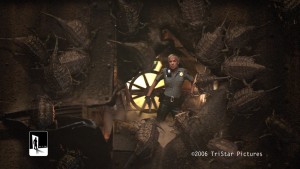
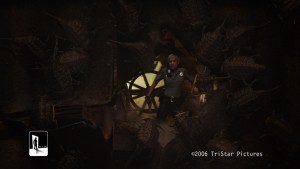
The movie version of Silent Hill is based on a very popular video game from Konami. The film’s director, Christophe Gans, was a huge fan of the game and pursued the game’s creator about making it into a film. They were impressed by his knowledge of the game and gave him the rights to the project.
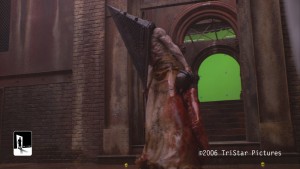
There were three primary VFX companies BUF Compagnie in Paris, France. CORE Digital Pictures and Mr. X , each of whom had visual effects supervisors on set. While some other companies came in to the team, on set the three principle VFX supervisors worked closely together.
HDRs were shot on each set that was used, which proved to be very useful.
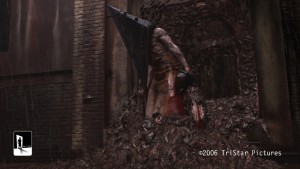
There were shots where the roaches needed to be overwhelming, up to waist deep high. The ingenious solution was the unwarping UV co-ordinates. These were combined with raising the ground plane into a wave like surface, which then had procedural roaches animated over them.
The lead of the tracking team was was Matt Ralph. While Boujou was used, a large number of shots were hand tracked in Maya. Thiswas only possible given the detailed on set measurements and the fact that most of the environments were geometric, and lent themselves to manual alignment.
In addition to the roaches themselves, Mr. X undertook a variety of other effects in the roach sequence including set extensions, CG rain, CG swords, exploding roaches, etc.
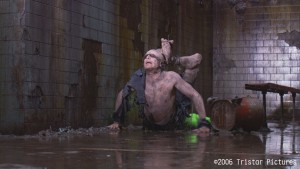
One of the most interesting challenges indirectly involved the roaches. “The original script called for the roaches to crawl out of the drain in the floor,†recalls Jacobs. “It was clear that Christophe wanted to do something more elaborate, so we began exploring having them form from bubbling rust in the wall. That ultimately led to the addition of a new character, the Janitor, causing an infection that forms veins in the walls and finally large egg sacks, which the roaches crawl out of. It’s pretty gross stuff, but this is the way Christope thinks!â€
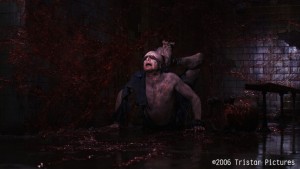
Patrick Tatopoulos, was the production designer of interpreting the computer game characters for the film. The Janitor character design, however, fell to Toronto based make-up effects artist, Paul Jones who provided all the on-set make-up effects for the film. The Janitor character had his legs bent backward and his feet were tied to his head with barbed wire. While the performer playing the Janitor was very limber, it was unrealistic to expect him to move in this position. Instead, the make-up effects team fabricated dummy legs and a pair of green pants for his real legs. Mr. X then digitally removed his legs from all the shots in the sequence.
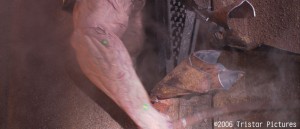
“The wall infection effect itself evolved quite a bit over time. We refined it over the course of several months,†said Jacobs. Ultimately, the effect was achieved with 3D elements from effects artist Kyle Yoneda and composited by senior compositing artist Rob Del Ciancio. “Christophe wanted the infection to be a part of the wall, not to grow on top of it,†recalls Jacobs. “It’s a subtle difference but it was very important to the director. Those guys had a great deal of patience. I think we did more revisions of those shots than any other shot on the show!â€
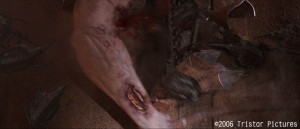
Another ‘non-roach’ effect involved adding computer generated bullet wounds to Red Pyramid’s arm. During Red Pyramid’s attack on the boiler room Cybil fires her pistol several times, hitting roaches as well as Red Pyramid.
“We were moving pretty fast during the shoot,†recalls Jacobs. “We had always planned to shoot make-up effects elements of the arm wounds so it could be achieved as a 2D effect but we just ran out of time and never got back to it. So in post, we had to add completely CG wounds to several shots.â€
After ruling out a 2D approach, Mr. X moved forward with a full 3D solution. “I was pretty nervous about doing these soft-body tracks in such close camera angles,†said Jacobs. “We put together a small team to focus on these shots. Finally, the 3D elements were handed off to Aaron Weintraub, the compositing supervisor on the show.â€
